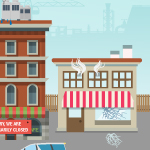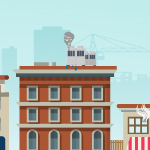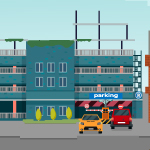Brownfield Redevelopment Riskopolis – Business Interruption
While all redevelopment projects have the potential to uncover environmental risks, using a brownfield site for an infrastructure expansion or development project can unveil additional contaminants related to past operations.
The Brownfield Riskopolis Series illustrates the process of redeveloping a brownfield site and how our Environmentalville crew hurdles numerous environmental exposures along the way. From ground water contamination to adverse weather-triggering incidents, despite all the setbacks, our crew successfully completed the development of a diverse shopping center!
Are environmental risks ‘sealed’ after a business is officially ‘open’? The answer is no. We have grown accustomed to the reality that unprecedented events are inevitable and in order to run a successful operation, it is important for business owners to take preventative action against potential exposure. Regardless of their operations, business interruption incidents may occur, resulting in costly remedial action and temporary shutdowns.
Are your business owner clients protected from these lurking environmental dangers? Take a closer look at each one by clicking on the numbers!

12. The presence of legionella was detected in the hot water system of a barber shop. The state health regulatory agency became involved and a qualified consultant was hired to investigate and remediate the property. A claim was made immediately for the extensive remediation process and significant business interruption that followed.

13. City inspectors received notice of possible building violations at a general store. Inspection of the store found the building’s roof and interior were in violation of city codes. The violations were serious in nature including signs of water damage on ceilings, light fixtures and electrical switches. Additionally, several employees reported a mold/ mildew odor. Further investigation discovered black mold within ceiling tiles, under layers of peeling paint and in areas of noticeable water leakage. Employees of the store were showing symptoms of rashes, headaches, asthma and difficulty breathing. The store had to be temporarily shut down to complete the extensive mold clean-up. Several employees filed suits for bodily injury against the facility.

14. Several months after opening, a contractor for a dry cleaner utilizing PERC installed a ventilation fan system in its vapor barrier room. The ventilation fan was intended to collect vapor and exhaust it through the stack above the building, relieving dense buildup. The fan was installed correctly; however, due to an alleged manufacturing error, the fan malfunctioned. Unfortunately, several employees of the dry cleaner complained that they suffered injuries from being exposed to the vapor in the building. The dry cleaner was forced to temporarily shut down.

15. Over a holiday weekend, vandals climbed the back fence of the dry cleaner. They broke a window and also damaged a valve on a fluid tank that was stored inside the facility. Unfortunately, the damaged valve leaked and wasn’t discovered for several days. Clean-up of the spill required removal of a portion of the concrete flooring and additional costs and extensive business closure for special disposal and site restoration.

16. During an extreme winter freeze, a pipe and valve malfunctioned on a residential rooftop HVAC system. The incident caused water to leak into approximately five floors of the hotel affecting approximately 15 rooms, saturating the drywall and causing mold to grow. Extensive remediation was necessary, leading to the closure of the five affected floors for several weeks.

17. During renovation of a new retail store, pipes froze during the winter months because of a failure to maintain and enclose the building envelope and to provide adequate temporary heating while the HVAC system was being replaced. The frozen pipes resulted in water infiltration and mold infestation in the building. Remediation delays followed. The business owner sued the general contractor, who then brought the subcontractors into the suit.















